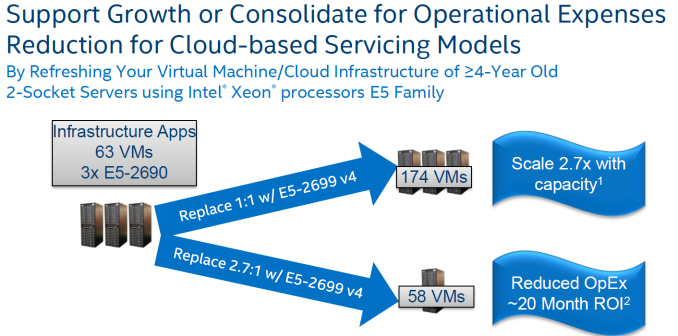The Intel Xeon E5 v4 Review: Testing Broadwell-EP With Demanding Server Workloads
by Johan De Gelas on March 31, 2016 12:30 PM EST- Posted in
- CPUs
- Intel
- Xeon
- Enterprise
- Enterprise CPUs
- Broadwell
Closing Thoughts
With the limited amount of time we had to spend with the new Broadwell-EP Xeons ahead of today's embargo, we spent most of our time on our new benchmarks. However we did a quick check on power as well. It looks like both idle power and load power when running a full floating point workload have decreased a little bit, but we need to do a more extensive check to further confirm and characterize this.
Meanwhile, considering what a wonderful offering the Xeon E5-2650L v3 was, it is a pitty that Intel did not include such a low power SKU among our samples for review. The Xeon E5-2699 v4 is a solid product, but it's not a home run. Either this is just an hiccup of our current setup (firmware?), but it seems the new Xeon E3 v4s do not reach the same turbo speeds as our Xeon E5 v3s. As a result, single threaded performance is (sometimes) slightly slower, and the new processor needs more cores to beat the previous one.
We noticed this mostly in the HPC applications, where the new Xeon is a bit of mixed bag. Still, considering that 72 to 88 threads are a bit much for lots of interesting applications (Spark, SQL databases...) there is definitely room for processors that sacrifice high core counts for higher single threaded performance (without exagerating). We have been stuck at 3.6 GHz for way too long.
With that said, there is little doubt that the Xeon E5-2699 v4 delivers in the one application that matter the most: virtualization.
Although we have not yet extensively tested on top of an hypervisor, we are pretty sure that the extra cores and the lower VMexit latencies will make this CPU perform well in virtualized environments. Intel's resource director technology and many improvements (posted interrupts) that help the hypervisor to perform better in I/O intensive tasks are very attractive features.
Although it is not much, as compared to the Haswell-EP based Xeon E5 v3s, performance has also increased by about 20% in key applications such as databases and ERP applications. And while we can complain all we want about the slightly regression in single threaded performance in some cases, the fact of the matter is that Intel has increased performance by 2 to 2.7 times in four years in those key applications, all the while holding power consumption at more or less the same. In other words, it will pay off to upgrade those Sandy Bridge-EP servers. And for many enterprises, that is what matters.











112 Comments
View All Comments
Casper42 - Thursday, March 31, 2016 - link
HPE just dropped the 64GB LRDIMMs a week or two back.They are now exactly 2x the 32GB LRDIMM as far as List Price goes.
LRDIMMs across the board are 31% more expensive than RDIMMs.
wishgranter - Tuesday, April 5, 2016 - link
http://www.techpowerup.com/221459/samsung-starts-m...wishgranter - Tuesday, April 5, 2016 - link
While introducing a wide array of 10nm-class DDR4 modules with capacities ranging from 4GB for notebook PCs to 128GB for enterprise servers, Samsung will be extending its 20nm DRAM line-up with its new 10nm-class DRAM portfolio throughout the year.nathanddrews - Thursday, March 31, 2016 - link
Perf/W is obviously a very exciting metric for server farmers and it generally exciting from a basic technology perspective, but it's absolute performance isn't amazing. Anyway, it's not like I'll be buying one anyway. LOLasendra - Thursday, March 31, 2016 - link
This interest me in so far as this would be the updated processors in a supposedly-coming-this-year Mac Pro refresh. Not that I would personally fork that much cash, but I'm interested to see how much of a jump they will make.But things seam rather bleak. No wonder they decided to wait 3 years for a refresh.
MrSpadge - Thursday, March 31, 2016 - link
Not sure which years you're counting in, but for the majority of us it takes 1.5 years from 09/2014 to today.https://en.wikipedia.org/wiki/Haswell_%28microarch...
asendra - Thursday, March 31, 2016 - link
Apple didn't update the MacPros with Haswell-EP. They are still using Ivy Bridgetipoo - Thursday, March 31, 2016 - link
Wonder what they'll do on the GPU side though. Too early for next generation 14nm FF GPUs from anyone, if Nvidia was even a choice due to OpenCL politics. Another GCN 1.0 part in 2016 would be...A bag of hurt.
Still waiting on the high end 15" rMBP to have something better than GCN 1.0...The performance, shockingly, hasn't come all that far from even my Iris Pro model. Maybe double, which is something, but I'd like larger than that to upgrade from integrated...
extide - Thursday, March 31, 2016 - link
Nah, if they refresh it late this year, like in august or something like that, then 14/16nm FF GPU's will be available.At worst we would get GCN 1.2, but yeah it would suck to see 28nm GPU's put in there...
mdriftmeyer - Thursday, March 31, 2016 - link
On what planet do you not grasp FinFET 14nm end of June from AMD?